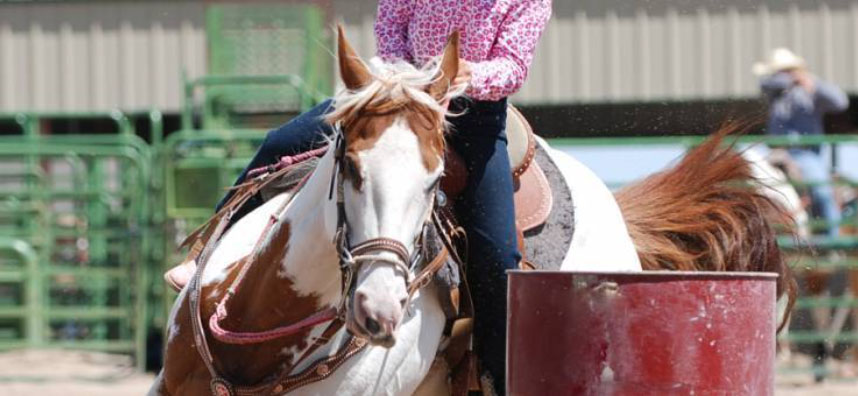
By Kentucky Equine Research Staff
Competitive horses often present to veterinarians with concerns about upper respiratory noise and poor performance. Researchers determined the prevalence of upper airway obstruction by retroactively reviewing medical records of barrel racing horses subjected to overground endoscopy. Upper airway obstruction was common, and over half of those horses were diagnosed with multiple causes of obstruction.
Upper airway obstructions involve structures located in the region of the soft palate and larynx at the back of the throat and include conditions such as:
- Pharyngeal lymphoid hyperplasia;
- Nasopharyngeal collapse;
- Palatal instability;
- Intermittent dorsal displacement of the soft palate;
- Medial deviation of the aryepiglottic fold;
- Recurrent laryngeal neuropathy;
- Vocal fold collapse;
- Ventromedial luxation of the apex of the corniculate process of the arytenoid; and
- Cricotracheal ligament collapse.
“Any of these conditions can have detrimental effects on ventilation and gas exchange, resulting in poor performance,” said Catherine Whitehouse, M.S., of Kentucky Equine Research.
Barrel racing is an anaerobic event that involves sprinting through a cloverleaf pattern at high speed, typically in less than twenty seconds. According to veterinary experts, barrel racing horses are frequently referred for airway evaluations with complaints of roaring and gurgling.*
To improve their understanding of upper airway abnormalities in barrel racing horses, the researchers reviewed the videos obtained during overground endoscopy. This procedure is performed by placing a portable endoscope into the airways of horses and then evaluating the upper airway structures during rest and exercise. In total, 164 Quarter Horses involved in barrel racing underwent overground endoscopy.
No abnormalities were identified in 15% of the evaluated horses during exercise, which means most of the horses were diagnosed with upper airway obstruction. Over half of the horses with abnormalities (56%) had more than one upper airway obstruction, with a total of 279 observed obstructions during exercise. In the 140 horses with upper airway obstructions, the most common abnormalities were nasopharyngeal collapse (49%), pharyngeal instability (42%), and intermittent dorsal displacement of the soft palate (39%). This means that abnormalities of the soft palate and pharyngeal walls occurred more commonly than those involving the larynx.
While airway obstructions are traditionally believed to occur at high speed, the upper airway obstructions noted in this review showed that 55% occurred at low-speed, low-intensity work rather than during the high-speed, high-intensity portion of the exam (only 22%). Specifically, intermittent dorsal displacement of the soft palate was 19 times more prevalent during low-speed exercise. Some horses experienced upper airway obstruction during both low- and high-speed exercise.
“The researchers noted that finding more upper airway obstructions during low-speed, low-intensity exercise was unexpected. They suggested that dynamic upper airway obstructions are not simply due to extreme airway pressures experienced during high-speed exercise or muscle weakness. They proposed it could instead be due to muscular tension or increased contraction of the upper airway secondary to situational stressors or an anticipatory effect of exercise,” explained Whitehouse.
When abnormalities were observed during high-speed exercise, it was primarily during the final straight-line sprint to the finish rather than when turning around the barrels.
“The final sprint is when airway pressure changes are likely the greatest. Also, airway muscle fatigue may be a contributing factor at this point in the competition,” Whitehouse added.
Finding a high prevalence of dorsal displacement of the soft palate brings to light a recent study suggesting that upper airway abnormalities could be a result of asthma. That study suggested looking for evidence of equine asthma rather than focusing on the soft palate exclusively when faced with horses presenting for upper respiratory noise or poor performance.**
For equine asthma, allergen avoidance and using medications such as bronchodilators and corticosteroid anti-inflammatory drugs in conjunction with high-quality marine-derived omega-3 supplement are the treatments of choice based on the most recent guidelines.***
“EO-3 and other antioxidant products developed by Kentucky Equine Research are recommended for horses exhibiting poor performance. Providing these nutrients can help reduce the negative impact of oxidative stress created by intense exercise and demanding competition schedules. Consider adding EO-3, Nano-E, and Nano-Q10 to your feeding program to support health and performance,” Whitehouse recommended.
Reprinted courtesy of Kentucky Equine Research. Kentucky Equine Research is an international equine nutrition, research, and consultation company serving horse owners and the feed industry. Our goals are to advance the industry's knowledge of equine nutrition and exercise physiology, apply that knowledge to produce healthier, more athletic horses, and support the nutritional care of all horses throughout their lives. Learn more at KER.com.
There a more informative articles in our section on Health & Education.
*Massie, S.L., and R. Léguillette. 2023. Upper airway endoscopy in exercising horses: Findings in 164 barrel racing horses with respiratory clinical signs and/or poor performance. Veterinary Journal 300-302:106038.
**Joó, K., Á. Povázsai, Z. Nyerges-Bohák, O. Szenci, and O. Kutasi. 2021. Asthmatic disease as an underlying cause of dorsal displacement of the soft palate in horses. Journal of Equine Veterinary Science 96:103308.
***Couëtil, L.L., J.M. Cardwell, V. Gerber, J.-P. Lavoie, R. Leguillette, and E.A. Richard. 2016. Inflammatory airway disease of horses—Revised consensus statement. Journal of Veterinary Internal Medicine 30(2):503-515.

































